Slack/tivism; Harnessing Political Movement(s)?
1.0 Introduction
“As the historian Robert Darnton has written “The marvels of communication technology in the present have produced a false consciousness about the past—even a sense that communication has no history, or had nothing of importance to consider before the days of television and the Internet.” But there is something else at work here, in the outsized enthusiasm for social media. Fifty years after one of the most extraordinary episodes of social upheaval in American history, we seem to have forgotten what activism is.” [1]
In ‘Small Change: Why The Revolution Will Not Be Tweeted’ [1], Malcolm Gladwell lambasted those who compared social media ‘revolutions’ or participation to high-risk, “strong-tie” physical activism such as the 1960s Greensboro sit-ins.
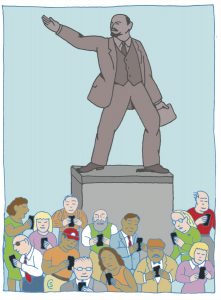
Whether Gladwell likes it or not, for better or for worse the existence of the internet and digital technologies have “transformed the meaning of citizen activism” furthering calls to what has recently been called as ‘micro-activism’ [2]. Through Christensen’s calls to the acknowledgement that “not all political participation is created equal” and the recent plea of Carroll of ‘policing of participation’ within the sphere of HCI, there is a concern for a loss of participation’s core values felt across the fields of HCI and Digital Civics [3]. As Gladwell demonstrated through the polarising views the valuation of higher-risk actions as more valuable over ‘micro’, low-risk actions, is it possible to determine what counts as ‘legitimate’ participation or in asking this question misses the point of Digital Civics entirely? As Digital Civics aims to “empower citizens through and with technology” [4], and calls for the field of HCI to acknowledge a diversification of participatory HCI [5] this is a point of concern that cannot be ignored.
Although Sal’s story in Weiser’s vision of ubiquitous computing is no more than a pipe dream currently (nb: Weiser’s dream of ubiquitous computing =/= computing being everywhere) with technologies;
“weaving themselves into the fabric of everyday life until they are indistinguishable from it” [6]
It is undeniable that with the IDC predicting an installed base of Internet of Things units at a Compound Annual Growth Rate of 17.5% from 2013 to 2020 reaching 28.1 billion units [7] whereby interaction and connection to a global network, interaction with political movements groups has the potential to require reduced levels of ‘risky’ and ‘active’ (physical?) participation.
In this blog post I first aim in Section 2.0 understand where the ‘slacktivist’ fits in the human computer interaction relation and discuss their digital interactions (clicking, liking) through GUIs. In Section 3.0 I aim to expand on this understanding of the physical performances of political action and suggest two areas within the fields of wearables and crowd-sourcing data; activism through collecting and activism through displaying to encourage greater levels of participation. As a counterpoint to this I also discuss the possibility of new measures to calculate ‘engagement’ and ‘effectiveness’ for future involvement with digital technologies.
2.0 Activist / Slacktivist?
Internet activism (digital activism, electronic activism, cyberactivism) is a growingly predominant version of activism that has captured my attention through its discussion in HCI [8][9]. It is defined as a politically motivated movement relying on the internet rather than activism that takes advantage of digital technologies to organise collective actions and amplify conditions for revolutionary movements to form (eg. through ease of communication).
Slacktivism, in my experience, is a highly polarising, pejorative term and specific form of internet activism measures that requires little physical or practical effect towards a political movement, traditionally having a “feel good” factor in making the individual feel satisfied that they have contributed explaining Gladwell’s earlier dispute of the enactments.
| Internet Activism | Activism |
| Internet = core framework | Digital technology = one tool of many |
According to McCaughey and Ayers classification of online activism in [10], three key categories of movements exist;
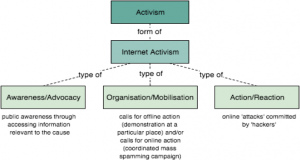
Gladwell’s earlier criticisms of slacktivism in 1.0 Introduction, appear only valid if activism at its core is defined as physical sit-ins, taking direct action and confrontation (Action/Reaction). For the purposes of this blog post, I shall be focusing on the Organisation/Mobilisation side of internet activism as this offline/online relationship is often contested in disputes involving slacktivism.
2.1 The ‘Slacktivist’, The ‘Computer’, The ‘Interaction’
My first naïve perception of the field of HCI came through Alan Dix’s book aptly titled ‘Human Computer Interaction’ [11] whereby the ‘human’ component, the ‘computer’ component and the ‘interaction’ component were separated into three neat sections as so;

By this model the ‘click’ of slacktivism is firmly placed within ‘The Interaction’ chapter, isolated from what might have motivated the action or how the action is situated within reality. A click really is just that, holding down a computer mouse button – low effort and easy. The first paper I was required to critically review was Kuutti and Bannon’s proposal of “The Turn to Practise in HCI: Towards a Research Agenda” [12] narrated the emergence of the novel ‘Practise paradigm’. The two identify two paradigms within HCI;
| ‘Interaction’ paradigm centred on scrutinising a dyadic human-machine relationship, displayed in limited short-term lab studies, all other human factors beyond modularised tasks categorised (in my opinion incorrectly) as “context”. | ‘Practice’ paradigm situating this interaction within a large material and cultural framework in which a human actor is situated is given the same prevalence as the interaction. |
Suddenly the field of HCI and models of understandings of online activism participation and ‘effectiveness’ become a whole lot more complex (read: messier) and interconnected as none of the three titular components could be easily separated into modular chunks. What caught my attention was the understanding that the slacktivist’s practise and performances with technology were no longer “momentary and ahistorical HCI situations” [12] that occurred within a vacuum, but acts of organisations, infrastructures, culture and rituals. Within the practise paradigm the click or petition signing of the slacktivist is just an individual performance taken from a wider background of activism, the interaction of the click can no longer be prioritised or isolated from the situated environmental and cultural meaning of the action. Effort, effectiveness and action must therefore be situated within the context it is performed to be understood and judged.
2.2 Effective Digital Actions; Sliding Scales of Participation
Now that digital participation has been clarified slightly, it is important to situate how ‘micro’ political participation scales against existing HCI and Digital Civics literature. As such I have combined Gladwell [1], Kwak [8] and Lee’s [9] discussion of activist actions and Digital Civics Week 4 seminar sessions surrounding activism to draw a sliding scale of participation.
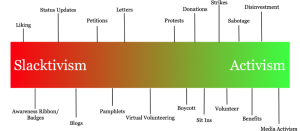
I believe there are immediate inherent problems with this model as actions alone cannot denote a better mode of participation than another; contributing money to a cause whom does not benefit the person in need is arguably just as bad as not contributing at all.
“The sum total of their support amounted to a computer click”
“Liking isn’t helping”
“… activism begins when the fingers leave the Apple keyboard …” [14]
Criticisms of low political participation appear to stem from two key understandings. Firstly, perceived non-action or a lack of effort to participate by reference to a sedentary, lone individual rather than physically active individual part of a public collective. To finish off the quote by Jason Sterns “… and the butt leaves the Herman Miller chair” [14]. Secondly, most criticisms seem to dispute a particular form of interaction with Graphical User Interfaces; a computer ‘click’ performed by a mouse and the use of an ‘Apple keyboard’. An area of HCI that provides both an alternative to the use of GUIs and physical non-action by incorporating the human capabilities of movement through manipulation of physical objects is that of Tangible Interaction.
3.0 Tangibility; Political Movement
“It’s all fed by slacktivism … the desire people have to do something good without getting out of their chair”
The subfield of Tangible Interaction within HCI has often been adopted by encouragement of offline citizen involvement in political matters due to the central theme of embodiment. This understanding allows greater flexibility on ‘things’ and ideas that are situated in the world with the reality of those ‘things’ dependent on the external effects of that setting, sitting neatly within Kuuttii and Bannon’s ‘Practise’ paradigm [12].
The core shift in this area however is the focus on the physical environment and physical representations of embodied mechanisms for interaction control. Tangible Interaction researchers akin to the critics of slacktivism appear to be unsatisfied with the limited performances of action though artefacts of GUIs aiming to incorporate more than just a keyboard and mouse. Parallels can clearly be drawn from the movement away from interacting with visual data towards physical embodiment to the transformation of lofty ideals into actions for mobilisation and protest within the activist sphere.
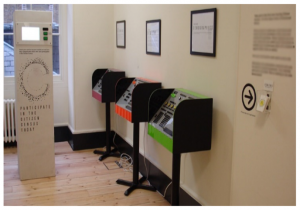
This parallel can be further evidenced through Connie Golsteijn’s Sens-Us that aimed to design “physical systems that draw people in” [15] a physical representation of the democratic Census process whereby designing a bespoke device with a range of physical input devices including buttons, knobs and dials would hopefully entice civic engagement more so than a digital form. Steinberger in Vote With Your Feet where Yes/No questions could be answered by stepping on one of two buttons on the ground focusing on “situated civic discourse” which reportedly substantially drove up the potential of attracting attention [16]. For purposes of clarification, the purpose of my point on tangibility isn’t to critique or promote tangible user interfaces directly, but rather the process of tangible interaction “giving form to digital information” [17] – questioning what is it about the physical performance of taking part in a process, the offline mobilisation that is somehow preferable to that of a digital one, an online mobilisation?
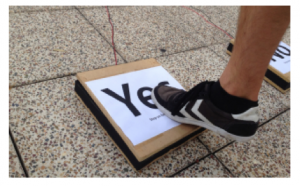
If we consider Wu’s response to this in [18], exploring how digital visualisations into a physical space to manipulate them directly changes the way in which people rethink their understanding of the relationship between representation of digital information and physical interaction. Even further from this, Anderson and Herr see a shift when abstract digital actions are brought into the realm of the physical from re-thinking relationships between action and results to re-learning, understanding through imitation or ‘learning by doing’.
3.1 Learning and Understanding Through Physical Performances
This shifts focus away again from action but rather the aftermath of performing the action with the interface; the learning produced by the performance of the action by the individual performer and the public to which sees this. As Ord and Smith discuss, knowledge has to be ‘discoverable’ (visible) if it is to make a difference in behaviour and increase a person’s commitment of understanding at involvement [19]. Perhaps there is a revolution to be had involving had involving keyboards and mice to incorporate this physical exertion that is clearly lacking from clicktivism.
What have I learnt about slacktivism from the understanding of this key field of HCI so far? That the gripe of lack of involvement is not purely lack of physical presence, but rather the performance of enacting physical offline actions that is more important; that somehow understanding or ‘learning by doing’ is essential, to which the slacktivist is excluded from. The concept of ‘learning by doing’ isn’t a new concept within HCI with strong work within the application of physically engaging wearable interfaces offering new means of self-expression and participation. As such I now intend to discuss two potential offline mobilisations through HCI wearable, ubiquitous technologies that may be able to solve the problem of low political participation; collection and display, which I intend to pursue further in future research.
3.2 Activism By Doing Wearing: Collecting
When costs of participation are low such as a click, a like or a share on a social media page, “demonstrating a new willingness for political participation” [20] what should be being done is harnessing these low-effort, low-risk but continuous methods. A slacktivist data collection process arguably flips the slacktivism on its head by positioning the advocator as instead of solely passively consuming data akin to a GUI user, the advocator is now an agent whom passively collects data.
Wilson (Open Lab, unpublished) incorporated the use of the geo-positioning facilities on the Apple Watch through the application Change Explorer to alert the wearer through push notifications of changes in planning regulations in that area. Users could respond through a limited scope of questions as to whether they agreed with the proposals or had any further suggestions. Gao in [21] discusses how crowdsourcing data can be collected “actively” requiring greater participant activity or “passively” that encourage users to submit small pieces of information typically via social media platforms.
A major risk of this however is the passive collection of data discussed previously is all that citizen science is used for; collecting data from “micro-contributions” whereby the final use and representation of the data being collected is foggy. A way of avoiding this concern as Rotman discusses in [22] to encourage continuous small contributions is clear communication of shared goals and a way of presenting personalised data.
3.3 Activism By Doing Wearing: Displaying + Acting
Taking wearables to the most literal sense Political Lace by Melissa Coleman provide individuals the chance to truly “wear what they stand for”, contrasting to wearables tracking health and fitness to look past the self, inspiring contemplation for a cause. In Political Lace the accessory’s LED fitted light blinks every seven and a half minutes – the frequency at which young women die unnecessarily at childbirth.

Perhaps a crucial difference of this type of display of data rather than wearing a pin or wristband is in part its connection to real time updates of events and information as they happen and the ability for the slacktivist to customise what data represents them within the movement. However, if it is not the slacktivist themselves who is left to determine what data can be collected or displayed then there are matters to be made aware of.
3.4 Communicating Through Data
By harnessing slacktivists as passive data collectors and displayers, the core way in which their micro-efforts can be put to use is through data. Data is an essential discussion topic in the ‘micro’ contributions of slacktivists through the heavy involvement of social media that automatically generates records of digital activity; number of likes, shares, responses. However, tension can arise when we take into account le Dantec’s understanding of crowdsourced data in particular; ‘data’ as a concept is not homogenous; many sources of data can be used and referred to, influencing political debate and discussions in a variety of different ways.
Through use of the two representations of cycle route data, in [23] the authors claimed to engage “multiple, polysemic voices” at one time that le Dantec claims that the two “authentically mirror participants’ contradicting and complex opinions”. Although I can appreciate the sentiment behind using data as a way of representing people’s voices, when it is collaboratively rendered without the essential elements of purpose, agency and individual sentiment it can serve as a hindrance rather than a help to the original contributor. This is as data can be shaped and moulded to fit contradictory points at a much greater flexibility than an individual participant can.
As such, ‘micro’ contributions seem to be only protected if the original slacktivists voice is heard so both fields of HCI and Digital Civics require to scrutinise to what extent voice can be supported through the platforms they are being submitted through.
4.0 Theoretical Implications and Evaluating Effectiveness
Perhaps it is not the encouragement of greater participation in the political process that is an issue but perhaps new theories or refinement techniques to better understand this clear “desire for a new form of political action” present in slacktivists. This might involve theories about motivation [19][20][21], voice and persuasion to encourage ‘micro’ or ‘macro’ forms of participation through digital technologies. Revised theories about risk and cost [22] might also understand motivations to participate in slacktivism and how that may or may not lead to enactment of physical forms of activism.
5.0 Conclusion
In conclusion, I explored an identified issue within HCI and Digital Civics of ‘slacktivism’ or ‘micro’ digital political participation through initially discussing the role of the slacktivist and how their actions can be understood within a practise framework. In understanding the actions in greater detail; the physicality of each action emerged and was discussed within the context of tangible interaction, exploring tangible user interfaces that aimed to promote greater ‘lightweight’ public participation in political issues. Potential solutions moving forward with tangibles and wearables were discussed through data collection and display before concluding with the theoretical implications of evaluating effectiveness of digital political movements. However, through this discussion key questions for future research still come into question when dealing with ‘micro’ activisms;
- How can the field of HCI and individual researchers measure or judge ‘effectiveness’ through mobilisation; do numbers matter or is it the attainment of the original activist goals?
- Should we press for greater involvement from participants through methods of persuasion or should researchers be exploring new ways of harnessing low but constant levels of participation and input by participants?
- If social media is criticised as being inherent to criticisms of ‘slacktivism’ what other platforms are appropriate to be utilised for mobilisation within the activist community?
6.0 References
[1] M. Gladwell, “Small Change: Why The Revolution Will Not Be Tweeted,” New Yorker, 2010.
[2] M. Weiser, “The computer for the 21st century,” Mob. Comput. Commun. Rev., vol. 3, no. 3, pp. 3–11, 1991.
[3] D. Lund and M. Morales, “Worldwide and Regional Internet of Things ( IoT ) 2014 – 2020 Forecast : A Virtuous Circle of Proven Value and Demand,” no. May, pp. 2014–2020, 2014.
[4] C. Crivellaro, “Digital Civics : Citizen Empowerment With and Through Technology Digital Civics : Citizen empowerment with and through technology,” no. April, 2016.
[5] Vines et al., “Summary Report on CHI 2012 invited SIG : Participation and HCI : Why Involve People in Design ?,” CHI ’12 Ext. Abstr. Hum. Factors Comput. Syst. 2012, 2012.
[6] M. McCaughey and M. Ayers, Cyberactivism: Online Activism in Theory and Practice. Routledge, 2004.
[7] A. Dix, “Human-Computer Interaction,” no. January 2004, 2016.
[8] K. Kuutti and L. Bannon, “The turn to practice in HCI: towards a research agenda,” Proc. 32nd Annu. ACM Conf. …, pp. 3543–3552, 2014.
[9] H. Kwak, C. Lee, H. Park, and S. Moon, “What is Twitter , a Social Network or a News Media?,” Int. World Wide Web Conf. Comm., pp. 1–10, 2010.
[10] S. Jason, “Slacktivists: Changing the world with ‘likes,’ clicks and tweets?,” FoxNews.com, 2012.
[11] C. Golsteijn, S. Gallacher, L. Capra, and Y. Rogers, “Sens-Us,” Proc. 2016 ACM Conf. Des. Interact. Syst. – DIS ’16, pp. 39–49, 2016.
[12] F. Steinberger, M. Foth, and F. Alt, “Vote with your feet: Local community polling on urban screens,” Proc. 3th Int. Symp. Pervasive Displays (PerDis ’14), p. 44, 2014.
[13] Tangible Media Group, Brygg Ullmer Thesis Defense. 2015.
[14] L. Smith, S. Lord, H. Building, J. Road, G. Scotland, and D. Mcmenemy, “Enhancing agency through information : A phenomenographic exploration of young people ’ s political information experiences,” 2013.
[15] J. Gao, Q. Li, B. Zhao, W. Fan, and J. Han, “Mining Reliable Information from Passively and Actively Crowdsourced Data,” Kdd ’16, pp. 1–2, 2016.
[16] D. Rotman et al., “Does motivation in citizen science change with time and culture?,” Proc. ACM Conf. Comput. Support. Coop. Work. CSCW, pp. 229–232, 2014.
[17] C. A. Le Dantec, M. Asad, A. Misra, and K. E. Watkins, “Planning with Crowdsourced Data,” Proc. 18th ACM Conf. Comput. Support. Coop. Work Soc. Comput. – CSCW ’15, pp. 1717–1727, 2015.
[18] A. Wu, “Tangible visualization,” Proc. fourth Int. Conf. Tangible, Embed. embodied Interact. – TEI ’10, p. 317, 2010.
[19] O. Stewart, D. Lubensky, and J. M. Huerta, “Crowdsourcing Participation Inequality : A SCOUT Model for the Enterprise Domain,” pp. 30–33, 2010.
[20] P. T. Fuglestad et al., “What Makes Users Rate ( Share , Tag , Edit …)? Predicting Patterns of Participation in Online Communities,” pp. 969–978, 2012.
[21] S. F. Forde, “Informational , but not Intrinsically Motivating Gamification ? Preliminary Findings,” pp. 157–163.
[22] Slovic, P. Perception of Risk. Science, 236, 4799 (April 17, 1987), 280-285.
Leave a Reply Cancel reply